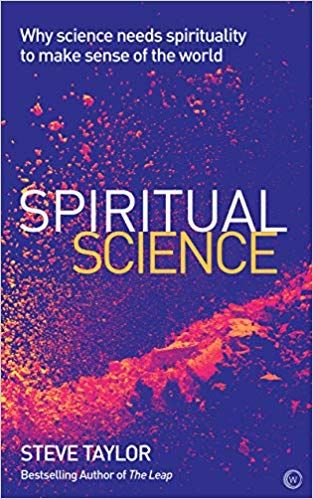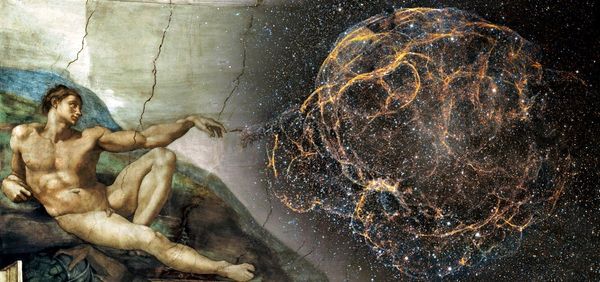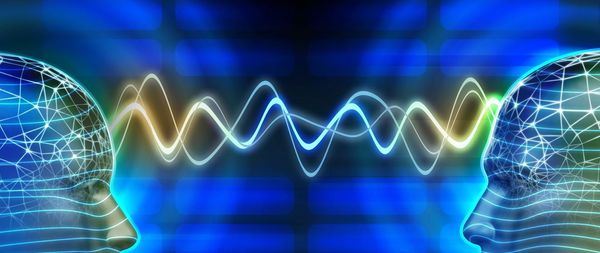Steve Taylor • • 20 min read
The Reality of Psychic Phenomena: Why Telepathy and Precognition Likely Exist

”Extraordinary claims require extraordinary evidence.”
— Carl Sagan
To many modern academic and intellectuals, belief in psychic phenomena like telepathy and precognition holds the same status as belief in fairies or alien abductions. Surely — so many of our peers seem to feel — we should have progressed beyond such irrational nonsense. If we accepted the reality of psychic phenomena, it would mean returning to a world of superstition and witchcraft.
In this article, I hope to convince you that this view is misguided. It is not at all irrational to accept the existence of precognition and telepathy. In fact, I will argue that there is so much evidence for them, together with theoretical and philosophical justifications, that it is actually irrational not to accept their existence.
Let me begin by clarifying what I mean by psychic phenomena, which I’ll do by making a distinction.
It is useful to think in terms of hard and soft paranormal phenomena. There are some types of paranormal phenomena whose existence is more questionable than others, because they don’t have a lot of evidence for them — for example, UFOs, alien abductions, fairies, haunted houses, demonic possession, or witchcraft. You could call these soft paranormal phenomena.
On the other hand, there are some types of paranormal phenomena that have been rigorously tested over many decades, and have accumulated a lot of evidence. Their existence also makes sense from a theoretical point of view, especially in terms of some of the theories and findings of modern physics. These are what I call hard paranormal phenomena. This mainly refers to phenomena that are sometimes referred to under the umbrella term of extra-sensory perception, or ESP. This includes telepathy, precognition and clairvoyance (or remote viewing).
Hard and soft paranormal phenomena are often lumped together, which makes it easy for them to be dismissed in toto — throwing the baby out with of the bathwater, you could say. However, if we examine the hard phenomena of ESP in separation, then it is much more difficult to dismiss them.
And it is these phenomena that I’m going to examine in this article. In fact, I’m mainly going to focus on two types of ‘hard’ paranormal phenomena, or ESP: telepathy and precognition. This is mainly for reasons of space. Psi is such a vast area that it would be impossible to cover every aspect of it. And I’ve chosen these two areas in particular because they have both been investigated so rigorously, over many decades.
Examples of Precognition
Surveys suggest that between a quarter and a third of people report having had at least one precognitive experience, most of which (around 75%, according to the researcher J.B. Rhine) occur in dreams.(1)
One well known and well corroborated example is of a man called John Godley, who dreamt the names of winning racehorses. One night in 1946, when he was a student at Oxford University, Godley dreamt he was reading a list of horse race winners in a newspaper and saw the names Bindle and Juladdin. The next morning he checked a newspaper, finding that two horses with those names were running that day. With a group of friends, he decided to risk a bet; both horses won and the group won large sums of money. This happened to Godley several times over the following years. The fourth time he had such a dream, he made a written statement of his predictions (again involving two horses), which was witnessed by a number of people, sealed in an envelope, stamped by a post office official and locked away until the day of the race. When this prediction came true Godley became famous around the world.
Frequently, precognitive dreams feature premonitions of danger. One of the most striking examples of ‘disaster premonitions’ is a man called David Mandell, a retired lecturer who, in the 1990s, began to have vivid dreams which he believed contained visions of the future. Since he was an artist, he started to paint scenes from the dreams. Then he would go to his local bank to have them photographed underneath an electronic clock, showing the date and the year. Eventually, he realised that he was seeing visions of future world disasters. For example, one painting showed a gas attack at an underground station, and in his notes accompanying the picture, Mandell mentioned that it would take place in Tokyo, and referred to a ‘secret group’ who came from the ‘hills.’ This seems to relate to the attack by members of the religious cult Aum Shinrikyo in 1995, who released sarin gas into underground trains in Tokyo, killing 12 people. The group did live in the hills outside Tokyo. There was also a picture of a Concorde aeroplane crashing at an airport, anticipating the crash in Paris in 2000. Mandell included a French flag in the picture, indicating that he was aware of the location. But most strikingly of all, on September 11th 1996, he photographed a painting which showed two burning towers falling into one another and also included an outline of the head of the Statue of Liberty and the silhouette of an aircraft flying downwards.
Mandell was happy to be investigated by scientists — he passed a lie detector, and forensic tests of the negatives of his photographs showed no signs of tampering. The well known sceptical psychic investigator, Chris French, devised a test to ascertain the accuracy of the paintings, in which 20 people were shown Mandell’s paintings and given his own interpretations of them together with alternative interpretations. They were asked to choose which interpretation best suited the paintings and in 31 out of 40 pictures, all 20 people chose Mandell’s interpretation – a result which French himself said was statistically very significant, so that Mandell’s claims deserved serious consideration.(2)
Empirical Evidence for Psychic Phenomena
Precognition has been empirically verified too.
In 2011, the eminent psychologist Daryl Bem — at the present time, professor emeritus at Cornell University — published a paper called ‘Feeling the Future’ in a prestigious academic journal, The Journal of Personality and Social Psychology. The paper described the results of 9 experiments involving more than 1000 participants, eight of which showed significant evidence for precognition.
Across a variety of different procedures, Bem found that his participants seemed to be able to ‘intuit’ information before it appeared. In a simple example, they were shown a pair of curtains on a computer screen, and asked to click on the curtain where they thought an image would be. At that point an image was randomly generated, and equally likely to appear behind either of the curtains. In eight of nine experiments, a highly significant number of the participants chose the correct curtain. And since no image was actually there at the time the participants chose, this was seen as evidence of presentiment.
Bem encouraged other researchers to repeat his experiments, and many did so over the next few years. Perhaps even more significantly than the original experiments, a meta-analysis of 90 attempted replications of the experiments (involving 12,406 participants in 33 different laboratories) showed a highly significant positive result. According to Bem, this provided ‘decisive evidence’ for his experimental hypothesis that human beings could sense future events.(3)
In fact, these findings would not be surprising to anyone who is aware of the history of psi research. As far back as the 1930s, the researchers J.B. and Louisa Rhine found that volunteers could guess which cards were going to be taken at random from a pack with a success rate three million times higher than chance.(4)
The psi researchers Charles Honorton and Diane C. Ferrari analysed the results of 309 ‘forced choice’ precognition experiments published between 1935 and 1977, involving more than 50,000 participants and published in 113 scientific articles. They found a highly significant success rate (the odds against which were 10 to the power of 24), which far outweighed any possible bias due to selective reporting.(5) A meta-analysis of more recent presentiment experiments (measuring human physiology before the presentation of startling images), between 1978 and 2010, found an even more significant positive result.(6)
Research on telepathy has had some similarly striking results. One of the standard experiments used to test for telepathy is the so-called ‘Ganzfeld’ procedure. This has been used since the 1970s. Typically, there is a ‘receiver’ who is deprived of external stimuli, wearing headphones and halved ping-pong balls over their eyes. A ‘sender’ tries to send an image to the receiver, who describes what (if anything) they are receiving. Afterwards, the receiver is shown four images, and asked to pick the one that was ‘sent’ during the experiment.
Obviously, the expected rate of success according to chance would be 25%. But over thousands of trials, the success rate has been significantly higher than this. A meta-analysis of more than three thousand Ganzfeld trials that took place from 1974 to 2004 had a combined ‘hit rate’ of 32 per cent. A seven per cent higher than chance rate may not seem so impressive, but over such a large number of experiments, this equates to many billions to one.(7)
Interestingly, Ganzfeld experiments with creative people have showed a significantly higher than normal rate of success. In 128 Ganzfeld sessions with artistically gifted students at the University of Edinburgh, a 47% success rate was obtained, with odds of 140 million to one.(8) Similarly, in a session with 20 undergraduates from the Juilliard school of performing arts, the students achieved a hit rate of 50%.(9)
Another study primarily with musicians had a 41% success rate.(10) One theory that may help to explain these findings is that psychic abilities are related to ‘labile’ or soft self-boundaries which enable people to be open to influences and energies beyond the normal conscious mind. This would also allow people to open up to artistic inspiration — and potentially spiritual experiences too.
Many other experiments with telepathy have had significant results. Experiments by the scientist Rupert Sheldrake have demonstrated the reality of ‘telephone telepathy’ and also that dogs may apparently have a telepathic connection with their owners. In a long series of experiments with a dog called Jaytee, Sheldrake found that it would sit by the window for a significant proportion of the time that her owner was on her way home – 55% of the time, compared to just 4% during the rest of her absence. (The sceptical psi researcher Richard Wiseman repeated Sheldrake’s experiment, and found that the Jaytee sat by the window for 78% of the time that its owner was traveling home, compared to 4% during the rest of her absence. However, Wiseman changed the requirements of the experiment, so that the dog was supposed to go to sit by the window at the exact moment that her owner set off home. Not surprisingly, by this criterion, the experiments were judged to be unsuccessful. Unfortunately this is not an isolated example of sceptical researchers ‘adapting’ the methodology of experiences to ensure that negative results arise.(11)
As sceptics of psi often point out, we shouldn’t necessarily accept these results at face value. It is possible that the positive results of some experiments — particularly earlier ones — were partly due to factors such as flawed methodology, poor controls or even fraud. But in recent times, the protocols of psi experiments have become extremely stringent, partly in response to the criticisms of sceptics.
Contemporary psi experiments (such as Daryl Bem’s) are actually more rigorously conducted than many experiments in other fields, because researchers are aware of the controversial nature of their experiments, and the intense scrutiny they will attract.
The File Drawer Effect
The ‘file drawer effect’ is sometimes cited as a possible reason why meta-analyses of ESP experiments show significant positive results. This simply means that, if an experiment comes up with negative results, it is less likely to be published. Researchers may be less likely to submit null studies for publication in the first place and even if they do, academic journals are less likely to publish them than positive studies. So according to this argument, there are many ESP experiments with negative results which have disappeared into oblivion, and so aren’t included in the meta-analyses.
However, there are some valid reasons why the file drawer effect can’t account for the positive results of ESP meta-analyses. Firstly, even early psi researchers were aware of the file drawer effect as a potential problem, and took measures to include it as a factor in analyses. J.B. Rhine devised a statistical method to calculate the effect of publication bias, and in 1975 the Parapsychological Association adopted a policy of publishing null results, so that they would always be included in meta-analyses. Following on from these measures, it has become common practice to measure study selection bias in psi research, using a variety of techniques.
And significantly, even when such techniques are applied, meta-analyses still show significant positive results. In the meta-analysis of Ganzfeld trials from 1974 to 2004 that I mentioned above, researchers calculated that 2,002 unpublished null studies would have been required to reduce them to insignificance. The average Ganzfeld study over this thirty year period consisted of 36 trials, and so the 2,002 other studies would have required 72,072 additional sessions – which would mean running Ganzfeld sessions continually 24 hours a day for 36 years.(12) In an analysis of 27 more recent Ganzfeld studies, researchers calculated that it would take 384 unpublished papers to nullify the results. Here it’s important to remember that, in recent times, not many psi experiments have been carried out. As the Parapsychological Association has had a policy of publishing null studies, it seems unlikely that such a large number of studies could have been performed then secretly filed away.(13)
Replication
Another issue that is often raised about positive psi findings is what scientists call replication. This is when experiments are repeated to find out if their results are reliable. A researcher could get a positive result in an experiment, only for other researchers to get different results, which would suggest that the original experiment was flawed in some way.
In practice, psi experiments have done pretty well at replication. Many experiments — such as the Ganzfeld tests, and Daryl Bem’s experiments — have been repeatedly replicated with success. But some materialistic scientists set the bar very high when it comes to psi, claiming that psi phenomena can’t be considered proven because they have not been replicated without fail. Just one experimental failure — amongst many other successfully ones — is seen as justification for invalidating a whole series of positive results.
For example, a team of sceptical psychologists led by the UK researcher Stuart Ritchie repeated one of Daryl Bem’s experiments, but didn’t have positive results. And despite the many other successful replications, this one failure was seen as justification for rejecting Bem’s ‘feeling the future’ hypothesis outright.(14)
However, in other areas of science, it’s very rare for a ‘one strike and you’re out’ policy to be applied. It’s not uncommon for research to be tacitly accepted before it has been replicated. In some cases, replication is never even attempted. And when it is attempted, rates of successful replications are extremely low. One team of researchers found a 25% replication rate(15), while others found an even lower rate of 11%.(16)
Compared to this, the replication rates of many psi experiments are impressive – as the above meta-analyses indicate. The thousands of repeated Ganzfeld and autoganzfeld (which is when the procedure is controlled by a computer) experiments since the 1970s with above chance results surely do constitute successful replication.
One argument that could be applied here is that, because psi is so controversial, the bar has to set high — as in the phrase (usually credited to the astronomer Carl Sagan) ‘extraordinary claims require extraordinary evidence.’ However, this seems prejudicial, like saying that certain types of criminals need high levels of evidence to prove their innocence. It is also debatable whether psi actually is extraordinary. Research has shown that significant numbers of people believe they have experienced psi, and most cultures throughout history have accepted it as a reality. It only seems extraordinary in the context of modern scientific materialism (which sees matter as the only reality, and the mind as the product of the brain.)
It’s also important to remember that ESP is not, by its nature, completely constant or reliable. You can’t compare testing for telepathy or pre-cognition to testing ‘standard’ psychological phenomena or processes such as attention, perception or memory. If they exist, psychic ‘abilities’ vary from person to person. In some people, they don’t appear to exist all, whereas others (such as creative people, as we have seen) may possess them to a high degree. Psychic abilities may also be situational; even with a person who normally demonstrates them to a high degree, there may be some circumstances when they fail — for example, when they are nervous or stressed.
In this sense, you could compare ESP abilities to creative abilities like painting or writing poetry. Some people have very little ability in these areas, perhaps none at all. Some people might be able to do them passably, and some people — probably the smallest group — are very skilled in them. And whether people do demonstrate their creative abilities is situational. Even a very skilled creative person may not be able to demonstrate his or her creativity in an uncongenial environment, in which they feel uneasy. Both ESP and creative abilities work best in states of calm and relaxation. (And as we saw above, ESP and creative abilities may be linked in that they are both linked to ‘labile’ self-boundaries.)
As a result, it’s not surprising that replications of ESP experiments are not always successful.
To expect otherwise would be like expecting all human beings to reliably demonstrate poetic abilities in laboratory experiments. And it is very impressive that, despite this, psi experiments do have relatively high rates of replication.
‘’More things in heaven and earth… than are dreamt of in [our] philosophy.’’
— William Shakespeare
Beyond our Normal Awareness
One reason why I personally have always been open the possibility of psi is that I don’t believe that we can, in William James’ phrase, ‘close our account’ with reality. Some materialist scientists tacitly assume that our present vision of reality is fairly reliable and complete. Whilst leaving some room open for new additions and amendments to our present understanding, they believe that the main elements of our worldview are solidly established. They assume that we have discovered the major forces and natural laws by which the world operates,
But I believe this is foolish and arrogant. Every animal has a limited awareness of reality. It is possible that, at some point in the future other living beings will come into existence who have a more intense awareness than us, just as we have more intense awareness than insects or sheep. These hypothetical beings may be more intensely aware of the phenomenal world around them than us, and aware of phenomena — e.g. forces, energies or laws — which are ‘selected out’ of our awareness, or beyond its range.
So it is probable that there is — in Shakespeare’s phrase, ‘more things in heaven and earth… than are dreamt of in [our] philosophy.’ There are almost certainly forces, energies and other phenomena in the universe beyond those which we can presently perceive and understand, or even detect. We may be aware of the effects of some of these phenomena, without being aware of the phenomena themselves — in the same way that, for example, an insect may be able to sense the heat of the sun without being aware of the sun as an entity in itself.
This is clearly indicated by quantum physics. There are so many well-established aspects of quantum physics (such as entanglement, ‘quantum tunnelling’ and wave/particle duality — all of which we will look at shortly) that seem to make no sense in terms of our normal understanding of the world. We know that they happen but we don’t understand how they happen — that is, we don’t understand the underlying forces or principles that allow them to happen. And this also applies to the forces or principles that generate — or would explain — telepathy and pre-cognition. Perhaps one day we will understand these forces; or perhaps they will remain forever beyond our awareness and our comprehension. In any case, the dogmatic assertion that psi doesn’t — and cannot — exist is probably a good example of what the philosopher Alfred North Whitehead described as ‘the self-satisfied dogmatism with which mankind at each period of its history cherishes the delusion of the finality of its existing modes of knowledge’.(17)
Does Psi Break the Laws of Science?
Some materialists argue that psi phenomena can’t be real because they contravene the fundamental principles of science. If they really existed, so it is argued, we would have to completely revise our understanding of physics. The sceptic Douglas Hofstadter argued along these lines in response to Daryl Bem’s work, writing that if its results were valid, it ‘would necessarily send all of science as we know it crashing to the ground.’(18)
But while psi might contravene some of the laws of classical Newtonian physics, it is completely compatible with many of the findings of modern physics (which isn’t necessarily to say that they can be explained in terms of quantum principles.)
Take precognition, for instance. The idea that the future may already exist in some way makes no sense in Newtonian terms. but it is completely compatible with more recent concepts in physics. According to modern physicists, the universe exists in four-dimensional space-time, and in these terms, the idea that time flows from the present into the future makes no sense. Rather than flowing, time is just there, in the same static way that space is. In other words, the whole of the past and the whole of the future are here now, existing side by side with the present. In four dimensional space-time, the concepts of past, present and future are meaningless.
According to the physicist Roger Penrose, ‘The way in which time is treated in physics is not essentially different from the way in which space is treated … We just have a static-looking fixed ‘space-time’ in which the events of our universe are laid out!’.(19)
Penrose goes on to suggest that our linear sense of time passing forwards is illusory, creating by our minds in order to impose upon our experience. (This is similar to the philosopher Kant’s suggestion that time and space are not innate aspects of the world, but ‘categories’ created by the human mind.) The idea that time passes, or that there is a past and a future divided by a present, has never been verified by any physical experiments. As another physicist, Paul Davies, noted: ‘As soon as the objective world of reality is considered, the passage of time disappears like a ghost in the night’ (20).
And from the standpoint of quantum physics, the idea that there are strict divisions between past, present and future seems simplistic and naive. In the microcosmic sub-atomic world, time seems to be indeterminate. Some quantum physicists claim that, at this level of reality, cause and effect can sometimes be reversed, so that an event can literally take place before its cause. There is even a term for this: retrocausality.
As the physicist Daniel Sheehan notes, ‘It seems untenable to assert that time-reverse causation (retrocausation) cannot occur, even though it temporarily runs counter to the macroscopic arrow of time’ .(21)
This notion was also accepted by founders of quantum physics such as Pasucal Jordan and Werner Heisenberg. After noting how the normal sequence of events is sometimes reversed in the quantum world, Jordan remarked that: ‘This has enormous implications for psychology and parapsychology, since such reversal of the cause-and-effect sequence are proved possible and philosophically valid’(22). Similarly, the ‘transactional’ interpretation of quantum mechanics sees quantum events as an interaction between waves that move both forwards and backwards in time. The originator of this approach, American physicist John Cramer, refers to a quantum event as a ‘handshake’ across space-time, where a wave is ‘offered’ out and it is ‘confirmed’ by another wave from the future. This means that, at the quantum level, time is a two way street, in which the future determines the past, as well as vice-versa.(23)
It is also very debatable that telepathy breaks the laws of physics. In quantum physics, there is a phenomenon called ‘entanglement’, which means that seemingly ‘separate’ particles are interconnected, reacting to each other’s movements. They can’t be treated as independent units but only as a part of a whole system. If a particle is divided into two, those two individual particles will always be ‘twinned.’ No matter how far they might be, they will behave as if they are connected. They will spin together in harmony, and balance each other’s random fluctuations. This suggests that, on the microcosmic level, all things are interconnected – which would offer the possibility of an exchange of information via telepathy.
It is important to note that the strangeness of quantum physics isn’t just confined to the microcosmic subatomic world. The relatively new field of Quantum Biology has shown that suggested that large-scale quantum effects happen everywhere around (and inside) us. Biological processes such as photosynthesis, olfaction (the sense of smell) and the reaction rates of enzymes may take place via entanglement, and ‘quantum tunnelling’ (where particles pass through solid barriers in a way that is impossible according to Newtonian physics).(24) These phenomena blur the distinction between the ‘supernatural’ and the ‘natural,’ making as little sense in terms of classical physics — and modern scientific materialism in general — as telepathy or precognition.
It is therefore invalid to say that telepathy and pre-cognition contravene the laws of physics, or would require a new model of science. In fact, it could even be argued that in modern physics, psi isn’t just conceivable, but inevitable. As the physicist Costa de Beauregard wrote ‘relativistic quantum mechanics is a conceptual scheme where phenomena such as psychokinesis or telepathy, far from being irrational, should, on the contrary, be expected as very rational.’ (25)
Significantly, the argument that psi contravenes the laws of psychics is usually put forward by psychologists and philosophers rather than physicists themselves. In fact, many physicists (such as Marie Curie, Wolfgang Pauli, Max Planck, Eugene Wigner, J.J. Thomson. David Bohm and John Stewart Bell) have been open to the possibility of psi.
In view of all of the above, there is more than sufficient reason to be open-minded about the existence of psi.
Phenomena such as telepathy and precognition do not at all contravene the principles of science – only the assumptions of materialism (e.g. matter is the only reality and the mind is the product of the brain.) And since there are so many ways in which materialism is deficient as a way of explaining the world and human behaviour, this is not problematic at all. (See my book Spiritual Science for a full discussion on this.) Psi phenomena are real — their existence makes sense from a theoretical point of view, even from a scientific point of view. Moreover, as we have seen, there is ample experimental evidence for their existence.
It is only the materialist worldview which deems precognition and telepathy as ‘supernatural’ or ‘paranormal,’ when really they should really be seen as possible as natural human capacities, which manifest themselves in certain unusual states of consciousness.
This article is an edited and adapted chapter of Steve’s book Spiritual Science.
Spiritual Science by Steve Taylor

Are you ready to embrace the possibility of psychic phenomena? Take a scientifically-driven ride deep down the rabbit hole with Spiritual Science, the latest book from Steve Taylor.
References
- Sheldrake, R. (2003). The Sense of Being Stared At: And Other Unexplained Powers of the Human Mind. New York: Crown Publishers.
- Taylor, S. (2007). Making Time: Why Time Seems to Pass at Different Speeds and How to Control it. Cambridge, UK. Icon Books Ltd.
- Bem, D., Tressoldi, P. E., Rabeyron, T., & Duggan, M. (2014). Feeling the Future: A Meta-Analysis of 90 Experiments on the Anomalous Anticipation of Random Future Events. Available at SSRN: http://ssrn.com/abstract=2423692 or http://dx.doi.org/10.2139/ssrn.2423692 Bibcode:2011Natur.474..272B. doi:10.1038/47427
- Rhine, J. B. (1997). Extra-Sensory Perception. Boston, MA: Branden. (Original work published 1934).
- Honorton, C. & Ferrari, D. C. (1989). ‘Future Telling’: A Meta-Analysis of Forced-Choice Precognition Experiments, 1935-1987. Journal of Parapsychology, 53, 281–308.
- Mossbridge, J., Tressoldi & P., Utts, J. (2012). Predictive Physiological Anticipation Preceding Seemingly Unpredictable Stimuli: A Meta-Analysis. Frontiers of Psychology, 3, 390.
- Radin, D. (2006). Entangled Minds. New York: Paraview/Pocket.
- Dalton, K .(1997). Exploring the Links: Creativity and Psi in the Ganzfeld. Proceedings of Presented Papers. The Parapsychological Association, 40th Annual Convention, 119–134.
- Bem, 1994. Bem, D., & Honorton, C. (1994). Does Psi Exist? Replicable Evidence for an Anomalous Process of Information Transfer. Psychological Bulletin, 115, 4–18.
- Morris, R., Cunningham, S., McAlpine, S. & Taylor, R. (1993). Toward Replication and Extensions of Autoganzfeld Results. Proceedings of Presented Papers. The Parapsychological Association 36th Annual Convention, Toronto, 177-191.
- Sheldrake, R. & Smart, P. (2000). ‘A Dog that Seems to Know When his Owner is Coming Home: Videotaped Experiments and Observations.’ Journal of Scientific Exploration, 14 (2), 233-255; Wiseman, R., Smith, M., Milton, J. (1998). Can Animals Detect When Their Owners are Returning Home? An Experimental Test of the ‘Psychic Pet’ Phenomenon. British Parapsychology, 42, 137–142.
- Radin, D. (2006). Entangled Minds. New York: Paraview/Pocket.
- Baptista, J. & Derakhshani, M. (2014). Beyond the Coin Toss: Examining Wiseman’s Criticisms of Parapsychology. Journal of Parapsychology, 78(1), 56–79.
- Ritchie, S. J., Wiseman, R. & French, C. C. (2012). Failing the Future: Three Unsuccessful Attempts to Replicate Bem’s ‘Retroactive Facilitation of Recall’ Effect. PLoS ONE 7, e33423.
- Prinz, F., Schlange, T. & Asadullah, K. (2011). Believe It or Not: How Much Can We Rely on Published Data on Potential Drug Targets? Nature Rev. Drug Discov., 10, 712.
- Begley, C. G. & Ellis, L. M. (2012). Drug Development: Raise Standards for Preclinical Cancer Research. Nature, 483, 531–533.
- Whitehead, A. N. (1948). Essays in Science and Philosophy. New York, NY: Philosophical Library, p.129.
- Hofstadter, D. (2011). A Cutoff for Craziness. New York Times online. Available at: http:// www.nytimes.com/roomfordebate/2011/ 01/06/the-esp-study-when-science-goespsychic/a-cutoff-for-craziness. Accessed 25/1/18.
- Penrose, R. (1999). The Emperor’s New Mind: Concerning Computers, Minds, and the Laws of Physics. Oxford: Oxford University Press, p.574.
- Davies, P. (1977). Space and Time in the Modern Universe. Cambridge: Cambridge University Press, p.221.
- Sheehan, D. P., (Ed.). (2006). Frontiers of Time: Retrocausation—Experiment and Theory. AIP Conference Proceedings. San Diego, California. Melville, New York: American Institute of Physics, ISBN 0735403619 link: https://philpapers.org/rec/SHEFOT, p.vii
- Jordan, P. (1957). New Trends in Physics. Proceedings of Four Conferences of Parapsychology Studies. New York: Parapsychology Foundation, p. 16
- Cramer, J.G. The Quantum Handshake: Entanglement, Nonlocality and Transactions. Heidelberg, NY: Springer, 2016.
- Vedral, V. (2011). Living in a Quantum World. Scientific American, 304 (6), 38-43.
- .De Beauregard, C. O. (1975). Quantum Paradoxes and Aristotle’s Twofold Information Concept. In Oteri, L. (Ed.), Quantum Physics and Parapsychology (New York: Parapsychology Foundation), 91-102, p.101.










